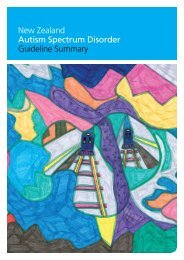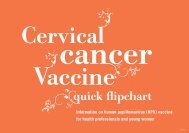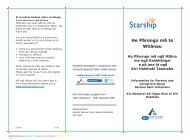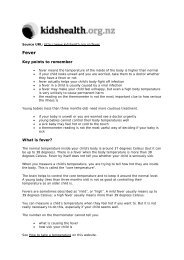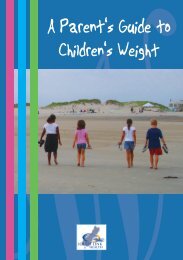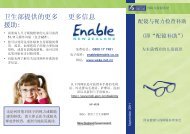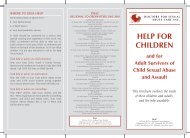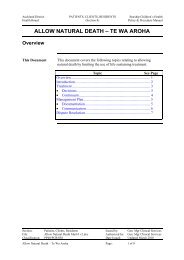New Zealand Autism Spectrum Disorder Guideline - Ministry of Health
New Zealand Autism Spectrum Disorder Guideline - Ministry of Health
New Zealand Autism Spectrum Disorder Guideline - Ministry of Health
Create successful ePaper yourself
Turn your PDF publications into a flip-book with our unique Google optimized e-Paper software.
Part 7: Mäori perspectives<br />
be assumed that silence indicates agreement.<br />
Encouraging whänau to take support persons<br />
with them when they attend meetings was<br />
also noted.<br />
The use <strong>of</strong> cultural protocols such as karakia was<br />
cited as being relevant to the process as were<br />
an understanding <strong>of</strong> whakawhanaungatanga<br />
and the upholding <strong>of</strong> the mana <strong>of</strong> the whänau<br />
during the process. Consultation with elders<br />
or the inclusion <strong>of</strong> a kaiarahi to guide and<br />
assist pr<strong>of</strong>essionals working with whänau may<br />
improve the process.<br />
14. Parents and whänau may need training<br />
and support to work on educational<br />
interventions with their son or daughter<br />
with ASD, for example, learning new skills<br />
to support generalising communication<br />
goals to the home or marae setting. Describe<br />
culturally appropriate ways <strong>of</strong> providing<br />
support and involving parents and whänau<br />
in educational interventions.<br />
The responses to this question were organised<br />
into three categories, namely:<br />
• home-based support<br />
• information support<br />
• marae-based support.<br />
Some participants thought that the best way<br />
to involve parents and whänau in educational<br />
interventions was to improve home-support<br />
initiatives. These included a kaiarahi making<br />
home visits to whänau, identifying the<br />
current skill-base <strong>of</strong> whänau in collaboration<br />
with service providers, and providing the<br />
opportunity for parents to access education and<br />
resources to become skilled in intervention.<br />
With respect to the latter point, a process<br />
was suggested whereby the kaiarahi, service<br />
provider, whänau and individual with ASD<br />
could together engage in cultural activities such<br />
as raranga, taiaha, haka, waiata, waka-ama<br />
and poi. This would potentially engender and<br />
facilitate a more collaborative approach.<br />
It was also mentioned that the provision <strong>of</strong><br />
childcare for other siblings when the parent<br />
is upskilling would be helpful, as would be<br />
making transport available along with kai. It<br />
was noted that providing educational resources<br />
that parents could use or make themselves<br />
would be useful.<br />
In addition, participants suggested that<br />
information support for parents and whänau<br />
could be improved. It was suggested that the<br />
setting up <strong>of</strong> an ASD 0800 support or text line<br />
where information from a Mäori perspective<br />
was provided, including information about<br />
treatments such as natural remedies, might<br />
improve participation. To facilitate a more<br />
collaborative approach it was also proposed that<br />
a marae-based environment might encourage<br />
greater family participation. Köhanga were also<br />
suggested as another culturally appropriate<br />
setting. Within these settings, whänau may feel<br />
more comfortable and material could also be<br />
provided in te reo Mäori.<br />
15. Lack <strong>of</strong> eye gaze from a young Mäori<br />
child could be an example <strong>of</strong> where<br />
someone’s cultural background could be<br />
misinterpreted as a communication problem.<br />
Are you aware <strong>of</strong> any other examples<br />
<strong>of</strong> possible cultural or communication<br />
understandings?<br />
The responses received to this question were<br />
grouped into three main categories. These are:<br />
• communication factors<br />
• contextual factors<br />
• cultural factors.<br />
Hui participants mentioned that it was<br />
important that pr<strong>of</strong>essionals listen to families,<br />
and limit their use <strong>of</strong> technical language and<br />
terminology when working with whänau. While<br />
not culturally specific, participants <strong>of</strong>fered the<br />
view that the Mäori child with ASD may lack<br />
a range <strong>of</strong> communication skills including the<br />
ability to effectively comprehend verbal and<br />
non-verbal behaviours. They may also have<br />
hearing loss and not be able to communicate<br />
using sign language. Some individuals are<br />
tactile defensive. Also noted was that there are<br />
Part 7<br />
<strong>New</strong> <strong>Zealand</strong> <strong>Autism</strong> <strong>Spectrum</strong> <strong>Disorder</strong> <strong>Guideline</strong> 209



